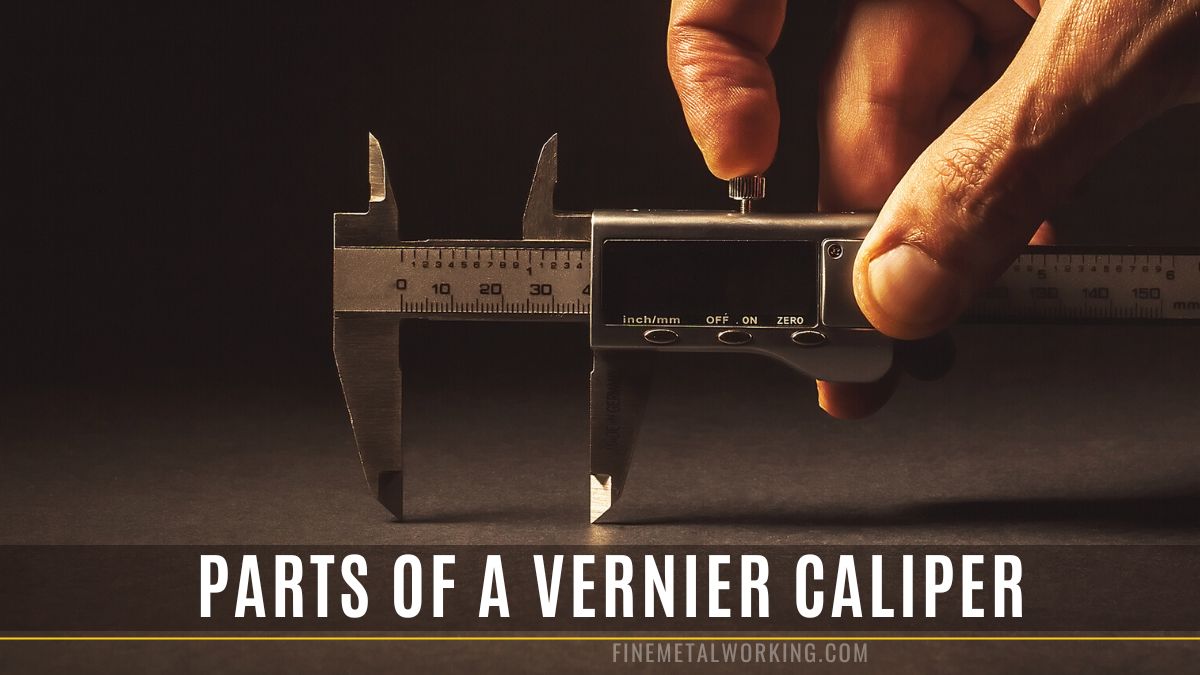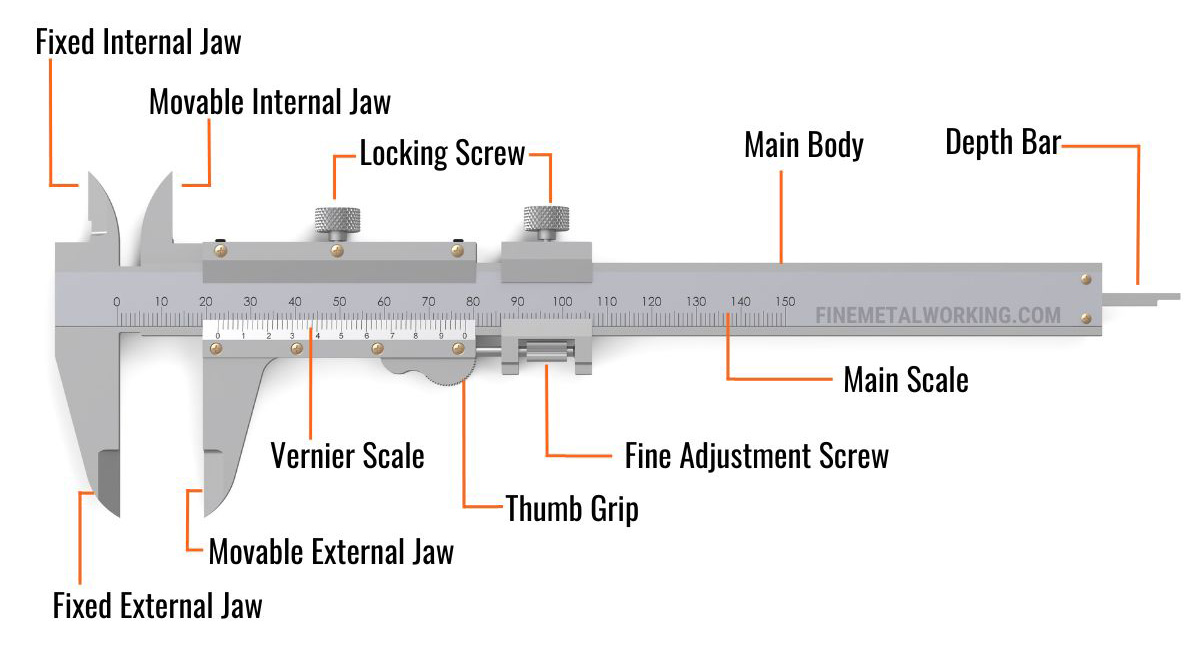A Vernier Caliper is a precision measuring instrument that consists of a main scale and a sliding vernier scale attached to the movable jaw, which is used to measure the internal and external dimensions of a workpiece or object with high accuracy.
Vernier Caliper Parts and Functions
The different parts of a Vernier scale caliper are as follows.
1. External Measuring Jaws
These are large lower jaws that are used for measuring the external dimensions of an object, viz., the external diameter of a cylinder, length of an object, diameter of a sphere, or any external dimension between two surfaces/points. As you can see, there are two external measuring jaws,
- Fixed Jaw: The jaw on the left side is a part of the main body.
- Movable Jaw: This is the jaw that slides along the main scale. The vernier scale is attached to the movable jaw.
These jaws may have carbide edges for longer tool life.
2. Internal Measuring Jaws
These are small upper jaws used for measuring internal dimensions, viz. inside diameter of a pipe, dimension of a groove or milled slot, etc.
Similar to the external jaws, the internal jaws are also two parts, with one fixed jaw and the other movable.
3. Main Fixed Scale
The main scale has a fixed upper and lower jaw on its left side and runs along the Vernier caliper. The length of the main scale depends on the size of the Vernier caliper, and it can be 150 mm, 300 mm, or more.
The graduations of the main scale can be metric or imperial (inches), or both. In the case of metric, the graduations are in millimeters, and in the case of imperial, the graduations are in inches.
4. Vernier Scale
The Vernier scale can be in metric or imperial or both, and it allows measurement of less than 1 millimeter (by interpolated dimensions). The number of divisions on the metric vernier scale can be 50; however, 50 divisions on the vernier scale will be equivalent to 49 divisions on the main scale or 49 millimeters.
The difference between these two values is known as the least count, which determines the accuracy of a Vernier scale caliper. See the detailed explanation on least count to learn how to read a Vernier caliper.
The vernier scale slides along the main scale (with the movable upper and lower jaws).
5. Lock Screw
Locks the vernier scale and enables reading the vernier caliper correctly.
6. Thumb Screw
This is located at the bottom of the vernier scale and gives you a firm grip for easy sliding of the vernier scale while holding the object firmly in the other hand.
7. Depth Rod or Depth Bar
The depth rod protrudes from the end of the main scale and moves out or in along with the movement of the vernier scale. You can use the depth rod for measuring the depth of a blind hole, a slot, and similar measurements.
8. Fine Adjustment Screw
The fine adjustment mechanism gives you better control over the movement of the vernier scale.
Lock the fine adjustment mechanism, but keep the vernier scale unlocked and rotate the fine adjustment screw to move the vernier scale to the desired position. This is useful in mass production when you want to keep the vernier calipers at a fixed measurement and quickly control the workpiece dimension.
Parts of Dial Calipers
Following are applicable only to dial calipers and digital calipers. They have all the parts of a standard Vernier scale calipers except the Vernier scale; instead, they have a dial or a digital display to show the measurement.
Display Dial
Reading a Vernier scale can be stressful, especially as you get older and your eyesight is not sharp anymore. The dial caliper solves this problem.
It has a display dial and needle that rotates as the movable jaw slides along the main scale. On a dial caliper, you can see the nearest whole number value next to the movable jaw, while the need on the dial indicates the deviation from it.
Dial Locking Screw
You can rotate the dial to adjust the position and use the locking screw to secure the display dial in that position.
Rack and Pinion
The precision machined rack-and-pinion mechanism rotates the needle accurately.
Digital Caliper Parts
The basic principles are similar to a dial caliper, but they do not have a rack and pinion mechanism or Vernier scale. The digital caliper has an electromagnetic linear encoder that enables it to measure the workpiece accurately.
Digital Display
As the name indicates, this is the digital display that shows the reading on a digital caliper.
Gone are the days of mentally calculating the dimension by carefully reading the Vernier scale. The digital caliper shows the measurement right on the screen.
These days you can get one at a very affordable price.
Depending on the model, you may have single or multiple buttons that enable you to set the origin, zero/reference position. and toggle between inches and millimeters.
Battery
Digital displays require a battery. When the battery power is low, you might see an indication on the screen (usually the letter B).
When the battery is low, replace it or, at the very least, remove the battery to protect your measuring tool.
Data Output Port
Some models have a data output port where you can connect an SPC cable. This allows you to connect the digital caliper to your metrology software and load the measurements directly.
You don’t need this if you are a hobbyist or small shop owner. The SPC data cable option is mainly for mass-production factories and laboratories.


